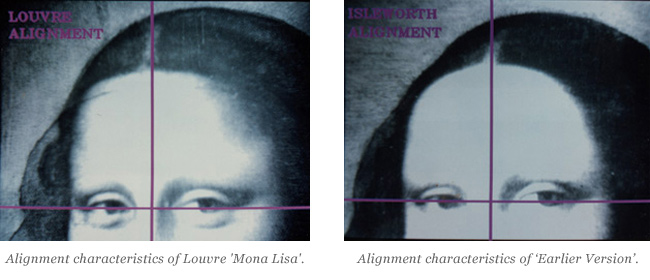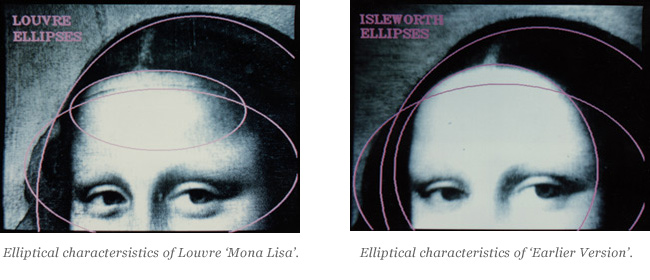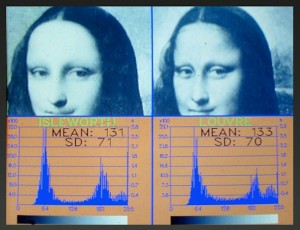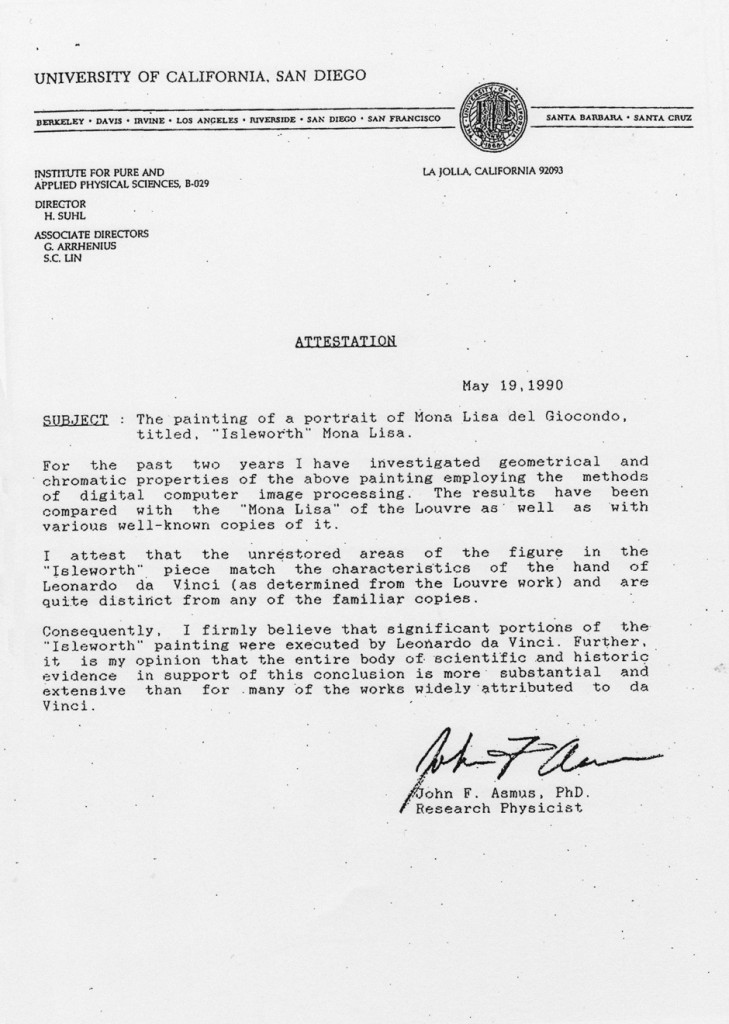
Research physicist, Department of Physics, Institute for Pure and Applied Sciences, University of California, San Diego. Professor at State Electrotechnical University, St. Petersburg, Russia.
Professor at State Electrotechnical University, St. Petersburg, Russia.
“It is a curious historical fact that Leonardo da Vinci painted two versions of what have become his most celebrated artworks. Most notable of these famous pictures are his ‘Virgin of the Rocks’ (London National Gallery and Louvre), ‘Virgin and Child’ (Hermitage and Munich Alte Pinakothek), and ‘The Virgin and Child with St. Anne’ (London National Gallery and Louvre). For centuries there has been speculation concerning the possible existence of a second Mona Lisa, as well, or rather the live portrait he must have painted of the young Lisa in 1503. Countless Mona Lisa copies have surfaced through the ages and several have been advanced as the long-lost other Mona Lisa, only to be dismissed after failing scientific and/or scrutiny based on historical facts.
Twenty-six years ago the heirs of the late Henry Pulitzer asked UCSD scientists to examine the ‘Earlier Mona Lisa’, a painting known as the ‘Isleworth Mona Lisa’ that was in the family collection of fine art. This invitation was extended in response to the earlier ten-year study of the varnishes, pentimenti, and craquelure of the Louvre ‘Mona Lisa’. These studies combined to point to the conclusion that the intricate geometrical principles employed in the two paintings were identical even though individual features are different in both size and proportion. Thus, it is evident that the portrait is not a mere copy of the painting in the Louvre, but is an original composition that happens to incorporate identical design principles.
Subsequently, the painting has passed every scientific test available in modern art conservation science in attributing it to the hand of Leonardo. These encompassed radiocarbon dating, pigment matching to Leonardo’s palette, infrared imaging of a planning drawing underneath, digital-image age regression, and UV imaging. Most significantly the statistical pattern recognition now based not only on a scientifically constructed data base of other accepted Leonardo attributions but also in comparison to many of the well known copies confirms to 99% certainty that the same artist painted both the ‘Earlier Mona Lisa’ face and the Louvre ‘Mona Lisa’ face.
It is probable that no other artwork, including the ‘Shroud of Turin’, has been subjected to such an array of exhaustive scientific tests. The inescapable conclusion emerges that Leonardo painted the ‘Earlier Mona Lisa’ around 1503 and the Louvre portrait around 1513, conforming to the customary standard that a valid theory must fit the facts, must be elegant, and must be the simplest explanation of the observations.
The latest scientific discoveries, together with the testimony of recently uncovered historical documents, settle the protracted debate among art historians as to whether Leonardo painted the Mona Lisa in 1503 or 1513 and not a single painting covering the whole period which can no longer fit the evidence. Both dates are in fact correct, but for two distinctly different paintings: the ‘Earlier Mona Lisa’ in 1503 when she was about 23 years old, and the Louvre ‘Mona Lisa’ ten years later.”
John F. Asmus
Professor John F. Asmus is a research physicist at the University of California, San Diego. He has been a pioneer in the digitization of artwork, with decades of experience in the science of art diagnostics more than any other professionals in the field and the person responsible for opening up the whole field of spectral analysis [see ‘Contributors’ for his biography]. Professor Asmus has developed cutting- edge scientific methods that go further than traditionally employed techniques to verify a painting’s attribution.
Professor Asmus’ distinguished palmares includes leading teams to study and advise on conservation of the famous Terra Cotta warriors discovered in China, sinking buildings in Venice and working beside Prof. Arnold who discovered carbon dating which he developed into a workable scientific technique. Professor Asmus is one of few people in the world to have examined closeup and in person both the ‘Earlier Mona Lisa’ and the Louvre version. The Louvre Museum gave Professor Asmus the very rare privilege of spending a day in private with their Mona Lisa. During his visit, he photographed the painting extensively, creating the first hi-resolution digital images. It was in fact these digital images by Professor Asmus that were recently sent by NASA to the moon.
Asmus had been working with some other art science programs, including the Rembrandt Institute, which had been analysing Rembrandt paintings. In search of a system to identify painters by their works, Asmus developed a method of mapping the billions of pixels he derived from imaging light and shadow (‘chiaroscuro’). His technique identified original Rembrandt self-portraits from copies with a 100% success record. He was approached to study the ‘Earlier Mona Lisa’. At that time his laboratory was located in the Scripps Institution of Oceanography where he was surrounded by researchers focusing on SONAR and RADAR pattern recognition for US Navy and oceanographic programs (e.g. the search for the Titanic by Jules Jaffe). He began applying their very successful spatial mathematical algorithms to the study of brush-stroke “fingerprint” characteristics of the major artists (e.g. Leonardo, Rembrandt, Goya, and Raphael) and numerous forgeries and copies of their works. The ‘Earlier Mona Lisa’ and the Louvre ‘Mona Lisa’ were the only Mona Lisa paintings that he analyzed with chiaroscuro/sfumato statistical characteristics that matched the hand of Leonardo (cross-correlation of 99%).
Essentially Professor Asmus’ technique identifies a “digital fingerprint” of artists through the statistical analysis of the modulation of brightness and shade, which can be mapped onto histograms reflecting billions of pixels. Professor Asmus was asked if he could use some of the same techniques he successfully used on Rembrandt paintings to compare the earlier and Louvre Mona Lisas. Prof. Asmus explains, as follows: “Initially, high-resolution images of the two Mona Lisas were loaded into specialized equipment, known as a digital computer image-enhancement system. As the two original photographs were of slightly different magnifications, it was necessary to scale the computerdigitized image files to precisely the same size. This was accomplished by adjusting the vertical scales so that the eye-level to chin distances were the same lengths in the two images.
It is well-known that analyzing geometric features was of paramount importance to Leonardo and that alignments, triangles, and vortices repeatedly emerge in his compositions. A suitable method of indicating such features in digitized images is to overlay guidelines in a noticeable colour with a graphical image editor. Just as Leonardo wove sophisticated geometric principles into the arrangement of the elements of his compositions, he also employed elegant geometrical shapes to form these individual elements. So whereas the majority of Renaissance artists followed similar principles, it is quite natural to suppose that Leonardo’s works would exhibit the flavour of his particular genius.”

In inspecting the major outline contours of the heads of both the earlier and the Louvre Mona Lisas, one notices similar elliptical characteristics. The graphical overlays demonstrate that the crowns of the heads, the hairlines, the veil edges and the bodices in both versions are constructed with similar but distinctive elliptical outlines. In this area, Prof. Asmus demonstrates that both paintings must have been executed by the same artist. To further this, Prof. Asmus introduces by example some typical Raphael compositions: the ‘Tiburtine Sibyl’ and the ‘Madonna del Divino Amore’. The construction principles of these works, though highly elegant and geometrical, are quite different from those of the two Mona Lisas, and this serves to highlight the unique relationship between the Louvre and earlier compositions.
 “One way of portraying the statistical characteristics of an image is through an amplitude histogram, which is a graphical plot that indicates the distribution of brightness levels throughout an entire scene or a portion thereof. Histograms are essentially “fingerprints” of the distribution of light and dark shading; a quantification of “chiaroscuro” which is so significant in Leonardo’s works. The only way of determining the efficacy of the histogram approach to identifying an individual hand in the execution of a painting is to develop a substantial data base for the purposes of comparison, and then comparing histograms of works by the same artist with each other. When the pixel distribution spans the 256-level range, the image has high contrast.”
“One way of portraying the statistical characteristics of an image is through an amplitude histogram, which is a graphical plot that indicates the distribution of brightness levels throughout an entire scene or a portion thereof. Histograms are essentially “fingerprints” of the distribution of light and dark shading; a quantification of “chiaroscuro” which is so significant in Leonardo’s works. The only way of determining the efficacy of the histogram approach to identifying an individual hand in the execution of a painting is to develop a substantial data base for the purposes of comparison, and then comparing histograms of works by the same artist with each other. When the pixel distribution spans the 256-level range, the image has high contrast.”
In the initial comparisons between the Louvre and earlier versions, the less complex black and white (monochrome) images were considered. These histograms portray the degree of whiteness (albedo). Histograms of the two heads are virtually identical, even though the images have noticeable differences. Referring to the data-base mentioned above, Prof. Asmus used portrait works of Rembrandt as points of reference, partly because of the large number of portraits that he painted, and also because a substantial proportion of these are of the same face – his own self-portraits. Again, as with the Mona Lisas, the histogram results show unique similarities in works of one subject; and Asmus expounds that an artist who paints the same face numerous times will do so with certain similar characteristics, not necessarily found even in other subjects by the same artist.
In examining Leonardo’s palette, histogram data was extracted for each individual primary colour (viz., red, green and blue), and a new database established, including works by Raphael, Rembrandt and Goya. The statistics for the different portions of each composition would be characterized by three individual histograms, which again resulted in strong similarities in the two Mona Lisas, especially in the foreheads and sleeves, and more so than with those paintings of the other artists.
 Finally, the detailed brushstrokes in the paintings were investigated statistically. One approach involved measuring the frequency with which pixel values change a small amount when moving to a neighbouring pixel. The statistics of such changes are plotted in a histogram. Spatial frequency plots for the eyes, nose, mouth and neck of each portrait are extremely close to one another, though some higher frequency peaks in the Louvre version were interpreted as being caused by more severe craquelure.
Finally, the detailed brushstrokes in the paintings were investigated statistically. One approach involved measuring the frequency with which pixel values change a small amount when moving to a neighbouring pixel. The statistics of such changes are plotted in a histogram. Spatial frequency plots for the eyes, nose, mouth and neck of each portrait are extremely close to one another, though some higher frequency peaks in the Louvre version were interpreted as being caused by more severe craquelure.
Prof. Asmus concludes: “The statistical analyses performed on both paintings were not exhaustive, nor were they intended to be. However, they were more extensive than those performed on any other collection of paintings. The work focused on the facial features rather than on such areas as hair, neck, shoulders or background. Clearly, the artist would have concentrated his attention on the face…” Interesting and important results emerged.

The Letter of Attestation, May 19, 1990. In this letter, Professor Asmus refers to the painting as the ‘Isleworth Mona Lisa‘, which as noted earlier, was the appellation to the ‘Earlier Mona Lisa‘ was known by at that time.
- The improvement in the aesthetic appearance of the earlier figure when placed on the Louvre background, and the geometrical construction similarities, suggest a common origin.
- Albedo measurements indicate that the shading statistics are virtually identical for the two versions.
- Spectral similarities indicate a common palette.
- Spatial frequency characteristics indicate an identical brush technique that is quite different from that of other artists.
Each of the above findings alone could be coincidental. These elements together demonstrates that both Mona Lisa faces must have been executed by the same artist. Professor Asmus has recently stated that he was amazed at how the histograms of the Earlier and Louvre Mona Lisas faces matched perfectly. The histogram distribution for the face of the earlier portrait and the histogram distribution for the face of the Louvre painting were almost identical; in fact the most identical that he had ever encountered between any two paintings. The other tests performed by Professor Asmus confirmed these results.
LATEST INVESTIGATIONS
Only recently, Professor Asmus applied his now well-validated method to other Leonardo paintings, as well as well-known copies of Mona Lisa, and found that the ‘digital fingerprints’ on those paintings were similar for the former while distinctly different in the copies, further proving that at least the faces of the ‘Earlier Mona Lisa’ and of the Louvre painting were executed by the same artist.
Together with Professor Vadim Parfenov, the leading research physicist at St. Petersburg State Electrotechnical University, and other collaborators, Professor Asmus is presently working to enhance the development of this cutting-edge method of identifying artists by their brushstroke technique in order to apply in a more general way for the identification of artists through their works.
The method is being met with great enthusiasm and acceptance in scientific circles. In 2014, they reached additional conclusions:
“In his writing Leonardo emphasizes his focus on sfumato and chiaroscuso in executing his art. When art historians and connoisseurs visually examine either a painting attributed to Leonardo or a candidate Leonardo painting, they will be assessing the manner in which the work exhibits his characteristic style in these features. Unfortunately, this is a highly subjective process and it is not uncommon for experts to reach divergent conclusions concerning a particular painting. To a considerable extent experience, prejudice, past attributions, and possible financial gain can color a finding. In recent decades an array of scientific tools have been introduced for the examination and attribution of art. Foremost among these are x-rays, carbon dating, infrared, and pigment chemical composition. Unfortunately, these are basically “negative” tests. If any of these tests are inconsistent with established markers for an artist, this artwork is excluded as a possible piece from that artist. On the other hand none of these tests are capable of proving that a piece is by the artist. Our goal has been to find such a positive test: a “fingerprint.”
We considered that taking histograms of like areas of different paintings might accomplish this as a sort of measure of sfumato and chiaroscuro. Of course you can establish the mathematical mean and variance of a histogram, but these values are subject to minor differences in the composition of a figure. Unfortunately, the act of interpreting and comparing histograms is also somewhat subjective.
It seems to us that artists such as Leonardo concentrated on important features of portraits themselves and frequently left less important aspects to assistants. We reason that in portraits it would be eyes, nose, and mouth that master artists would have focused upon. We suspect that individual artists would each have an aesthetic sense of the shading and relationship of these three important features. Thus we made histograms of eyes, noses, and mouths of the ladies in several portraits. Then, we plotted the variances of the three features for each painting on a 3D plot. We anticipated that this would reveal different artists sense of shading, sfumato, and chiaroscuro in an explicit diagram. In the example that we provided you will notice that ‘Earlier Mona Lisa’ and Louvre ‘Mona Lisa’ have almost identical “fingerprints” and are far removed from the statistical properties of the Prado, Oslo, and Flemish-school copies. More needs to be done to establish a more extensive data base, but this may lead to a test for the eye and hand of Leonardo.”

Based on these tests and the rest of the existing evidence, Professors Asmus and Parfeov have attested that it is 99% certain that the two Mona Lisas were executed by the same artist.15 In 2016, a new paper was published in a leading scientific journal (see https://www.researchgate.net/publication/311094302_Seeing_double_Leonardo’s_Mona_Lisa_twin). This peer reviewed publication confirmed the scientific world’s acceptance of the method and the results.